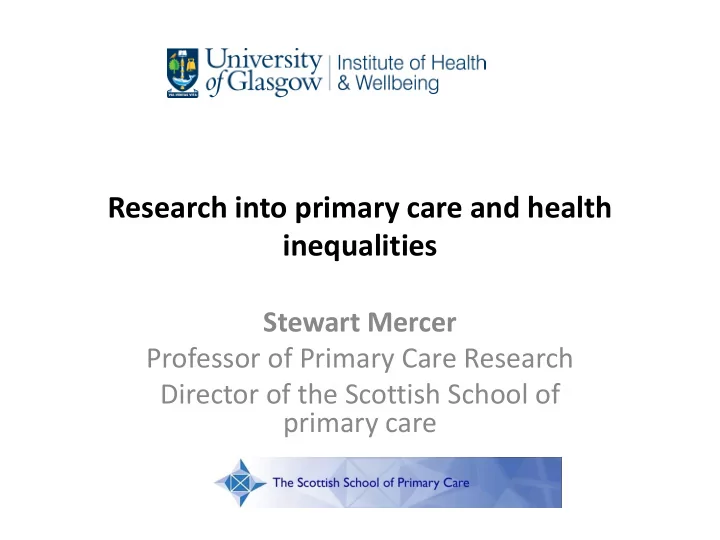

Research into primary care and health inequalities Stewart Mercer Professor of Primary Care Research Director of the Scottish School of primary care
ILL-HEALTH and Health inequalities in Scotland Dehealth ineqPRIVATION 180 160 140 120 100 Mortality <75 Limiting long-term illness Not good' general health 80 60 40 20 0 1 2 3 4 5 6 7 8 9 10 Deprivation decile
Multimorbidity in Scotland The Scottish School of Primary Care’s Multimorbidity Research Programme
Multimorbidity is common in Scotland – The majority of over-65s have 2 or more conditions, and the majority of over-75s have 3 or more conditions – More people have 2 or more conditions than only have 1
People living in more deprived areas in Scotland develop multimorbidity 10 years before those living in the most affluent areas
Mental health problems are strongly associated with the number of physical conditions that people have, particularly in deprived areas in Scotland
The Inverse Care Law Age & Sex Standardised Census Health Measures by Greater Glasgow & Clyde Deprivation Decile 250 200 Age-Sex Standardised Ratio 150 sir64 shr64 100 smr74 Linear (WTE GPs) 50 0 1 2 3 4 5 6 7 8 9 10 Deprivation Decile
The Inverse Care Law • ‘The provision of good medical care tends to vary inversely with the need for it in the population served.’ • www.juliantudorhart.org
Patients in deprived areas of Scotland do not feel enabled by GP encounters In a study of over 3,000 GP consultations in the West of Scotland, patients in deprived areas (compared to patients in more affluent areas) had : • More problems to discuss, which were more often complex (a mix of physical, psychological, and social); Yet…. • Consultations were shorter • Patients with complex problems were less enabled • GPs were more stressed Mercer SW, Watt GCM. Ann Fam Med 2007;5:503-510.
General practitioners and practice nurses in deprived areas struggle to support people with multimorbidity “Exhausting” “Demoralising” “If you’re too caring ... you’ll crack up in a place like this. Our boundaries lie “I feel like a where they are wrung-out rag because they have at the end of to at the moment” consultations” O'Brien R et al. Chronic Illness 2011;7(1):45-59.
Developing – whole system, whole person approach Patient- • centred Time • Continuity • Support and training for Understand Empowerment professionals Patients’ • Context Whole Self-management support for person patients Making Relationship patients feel valued
CARE PLUS: a whole-system approach Time, continuity, person centredness and self-management support Longer consultation System time with continuity System Support meetings Professional and structure for long person-centred Practitioner consultations Patient CD and written guide on mindfulness Patient Plus CBT guide Community activities recommended
Would GPs and patients participate in a RCT? Practices from areas of high deprivation N P = 8 Usual Care CARE Plus N P = 4 N P = 4 N = 76 N = 76 Patient Completed Questionnaires Baseline Baseline N = 76 N = 76 6 Months 6 Months N = 69 (91%) N = 68 (89%) 12 Months 12 Months N = 67 (88%) N = 67 (88%)
Satisfied with time spent in first Time spent in first index index consultation consultation 40 60 35 50 30 40 25 minutes 20 % satisfied 30 15 20 10 10 5 0 0 care + consulation first usual consultation care + consulation first usual consultation P<0.0001 P<0.0005
Are consultations ‘better’? care measure (% max score) PEI (% 'enabled') 50 35 45 30 40 35 25 30 20 25 15 20 15 10 10 5 5 0 0 care + consulation usual consulation care + consulation usual consulation ns ns
Patients in the CARE Plus group had improvements in quality of life and wellbeing at 12 months EQ5D-5L EQ5D-5L AUC W-BQ12 General Well-being W-BQ12 Negative Well-being* W-BQ12 Energy W-BQ12 Positive Well-being -0.4 -0.2 0.0 0.2 0.4 0.6 0.8 1.0 Effect Size (95% Confidence Interval) Favours Usual Care Favours CARE Plus Favours Usual Care Favours CARE Plus
CARE Plus prevents decline in QOL (EQ5-DL) 0.6 0.5 0.4 baseline 0.3 6-month 0.2 0.1 0 care+ usual care Effect size = 0.35
CARE Plus is also very cost-effective • Cost-effective: – Cost < £13,000 per QALY – NICE currently supports a cost of £20,000 per QALY
Summary • Health inequalities continue to widen • Multimorbidity is a major challenge • It is socially patterned, occuring earlier in deprived areas • Because of the inverse care law, GPs struggle to meet patients complex needs in deprived areas • ‘Reversing’ the inverse care law experimentally appears to improve outcomes in a very cost- effective way
Recommend
More recommend